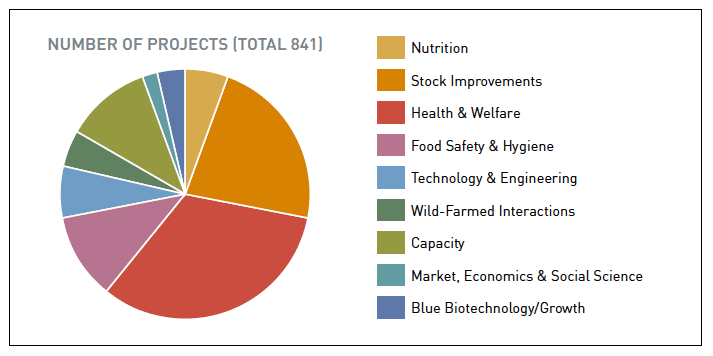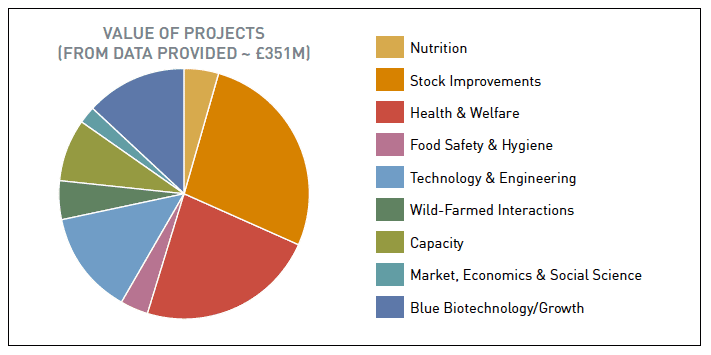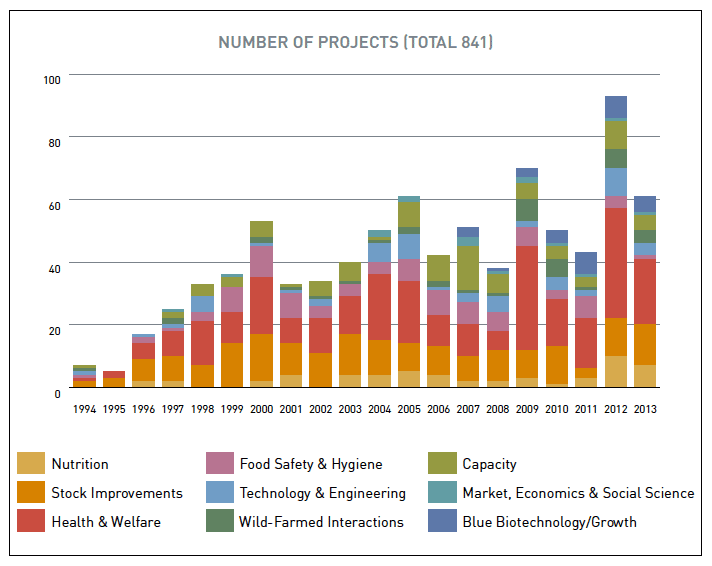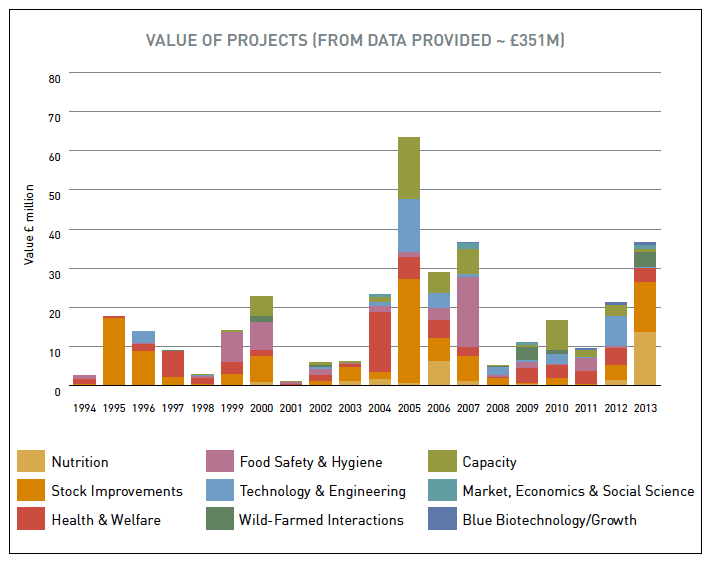MGSA Science & Research Working Group - Aquaculture Science & Research Strategy
MGSA S&RWG was tasked to produce a comprehensive research strategy prioritised on respective contribution to informing the sustainable growth of the Scottish aquaculture industry and potential impacts of the 2020 sustainable production targets as detailed
Preface
CONTEXT
Aquaculture is the world's fastest growing food producing sector (6-8% per year over the past 10 years) and now accounts for over half of the world's fish supply for human consumption. Projected population growth and per capita increases in seafood consumption coupled to plateauing and possible decline of capture fishery production dictates that future demand will need to be met by aquaculture. Globally, it has been estimated that aquaculture will provide approximately two thirds of global food fish consumption by 2030 as catches from wild capture fisheries level off and demand from an emerging middle class increases substantially [1] .
Despite Scotland experiencing growth in recent years, the aquaculture industry as a whole across Europe has stagnated which has led to an increased reliance on importing fish products from outside the EU. Aquaculture is therefore being promoted strongly in the Blue Growth Strategy, the Atlantic Strategy and the reformed Common Fisheries Policy ( CFP).
Scotland is the largest producer of farmed Atlantic salmon in the EU and 3 rd globally behind Norway and Chile (2012). Using DCF and FAO data, it has been estimated that the aquaculture sector production in the EU27 accounted for 1.32 million tonnes, with a turnover estimated at 3.99 billion Euros, in 2011. Spain, with 21% of the total EU production in volume, is the largest aquaculture producer in the EU, followed by France (18%), United Kingdom (14%), Italy (13%) and Greece (11%). These five countries account for more than 75% of the total EU aquaculture production in weight. In terms of value, the United Kingdom is the largest EU producer with 20% of the total EU aquaculture, followed by France (19%), Greece (15%), Spain (12%), and Italy (10%). These five countries are also responsible for more than ¾ of all the EU aquaculture value. Aquaculture production by the 28 European Union Member States ( EU28) reached 1.28 million tonnes and 3.51 billion Euros in 2011 according to FAO [2] .
In 2012, Scottish marine finfish production (164,380 tonnes) was dominated by farmed Atlantic salmon (162,223 tonnes) with 2,076 tonnes marine rainbow trout, 73 tonnes halibut and 8 tonnes sea trout also produced. Freshwater finfish production included 3,594 tonnes rainbow trout, 36 tonnes brown trout and 0.2 tonnes Arctic charr. In 2012, Scottish shellfish production was dominated by blue mussel (6277 tonnes). 216 tonnes of Pacific oyster (2,706,000 shells), 25 tonnes native oyster (317,000 shells), 0.4 tonnes queen scallop (9,000 shells) and 7 tonnes king scallop (58,000 shells) were also produced [3] .
Scotland is well placed to contribute significantly to future aquaculture production of high quality, healthy product and transfer of technology, expertise and best practice. Our coastal marine topography and hydrography provides numerous excellent sites for finfish and shellfish farms. We are also well placed to develop marine aquaculture in more exposed locations which, although technologically challenging, offer great potential. Such locations provide a means of sustainably growing the sector, reducing competition for space in inshore areas, and further minimising actual and perceived environmental impacts. There are exciting opportunities to co-locate aquaculture with marine energy installations, and multi-trophic aquaculture may provide co-operative approaches to mitigating economic and environmental costs and risks.
Scottish higher education and research institutes have a respected international reputation in aquaculture related research and training. This is reflected in the success of these institutions in securing research funding both domestically and at EU level. Graduates and postgraduates from our institutions populate senior positions within industry and regulation across the globe. The Marine Alliance for Science and Technology for Scotland ( MASTS) is a research pool that brings together the majority of Scotland's marine research capacity representing approximately 700 researchers and £66 million a year of public investment. MASTS members include one of the largest concentrations of scientific expertise in aquaculture in the world. The Scottish Aquaculture Research Forum ( SARF) is an independent charity tasked with prioritising, commissioning and managing applied aquaculture research, based upon the needs of industry and its key regulators and stakeholders. Much of the work commissioned by SARF has had a measurable and practical impact on the way aquaculture is conducted and managed in Scotland.
The Institute of Aquaculture at the University of Stirling is recognised as a leading international centre of excellence in aquaculture. The Scottish Association for Marine Science, Marine Scotland Science and the Universities of Aberdeen and St Andrews have a long and distinguished record of delivering cutting edge aquaculture research and innovation. More recently, Edinburgh Napier, Dundee and Strathclyde and Scotland's newest University - the University of the Highlands and Islands, are developing aquaculture related research capacity. Research interests span the full spectrum of aquaculture from applied production technologies through to cutting edge disease, nutrition and environmental research.
The Scottish Aquaculture Innovation Centre ( SAIC), is a virtual hub drawing together the collective expertise and resources found across its 13 research partners and its extensive aquaculture supply chain and will receive core funding through the Scottish Funding Councils ( SFC) Innovation Centres programme which is being delivered jointly by the SFC, Scottish Enterprise and Highlands & Islands Enterprise. It will deliver industry-lead aquaculture research and development, consultancy, knowledge exchange, education and training to support the sustainable growth of the aquaculture sector and retain Scotland's international reputation for the provision of premium, high quality, traceable and environmentally sustainable seafood.
Scotland has a world leading aquaculture industry underpinned by a substantive and internationally respected research base. The Government in Scotland supports industry targets to grow a sustainable sector with due regard to the marine environment as set out in the consultation draft of the National Marine Plan which articulates the 2020 aspiration:
Support the industry and other stakeholders to increase sustainable production by 2020 (from a 2011/2012 baseline) of:
- Marine finfish to 210,000 tonnes (159,269 t in 2011)
- Shellfish, especially mussels, to 13,000 tonnes (6525 t in 2012)
Thus, through its various working groups the MGSA will continue to underpin the objectives of delivering the Aquaculture and Fisheries (Scotland) Act, to facilitate the ambition of achieving the 2020 sustainable production targets, to improved co-ordination, innovation and leadership.
METHOD AND APPROACH
The Chair of the Science and Research Working Group (S&R WG) formed a Steering Group, the core of which comprised the Sustainable Aquaculture Research Forum of the Marine Alliance for Science and Technology for Scotland ( MASTS) together with additional representation from industry and Marine Scotland. The Steering Group agreed to the following division of subject areas:
- Nutrition
- Stock Improvement
- Health & Welfare
- Food Safety & Hygiene
- Technology & Engineering
- Wild-Farmed Interactions
- Markets, Economics & Social Science
- Capacity
- Blue Biotechnology & Growth
Individuals drawn from the Steering Group with relevant expertise were allocated the role of Task Group Leader and charged with convening a small Task Group of relevant experts to contribute to the process of identifying potential research requirements. The names of the proposed members of each Task Group were circulated to the Steering Group for comment to ensure an appropriate balance of expertise and representation was maintained. A list of Task Group members is provided in Annex 01.
The following process was adopted with the understanding that the strategy would, in the first instance, identify research gaps and any potential contingent deficiencies in research/infrastructure provision which might need to be addressed to contribute to meeting the 2020 sustainable growth targets for Scottish aquaculture production published in Scotland's National Marine Plan Consultation draft on 25 July 2013 [4] . In addition, Task Groups were charged with identifying key strategic research requirements which may be applicable in a broader scientific context and over longer timescales than might be applicable to the 2020 targets.
Overall, this process should recognise the complexity of the research funding landscape and the duality of informing and influencing funding whilst responding to opportunities which might favour academic or more applied research in this field.
The process of defining research requirements was similar for each task group and involved the following stages:
- Review of current strategies
- Review of relevant outputs from groups/fora that may be focused on defining research requirements - includes other MGSA Working Groups
- Analysis of an R&D database of projects funded over the last decade
- Consultation with relevant stakeholders - regulators, industry trade bodies and key industry players, NGO's - through established bodies such as SARF (this process was undertaken centrally and the results fed back to the task groups)
- Submit final draft of the S&R Strategy Task Groups to the MGSA for final comment and approval
With respect to their task subject area, each Task Group would:
- Identify and review any relevant 'strategies' that are current and either published or unpublished but available within their respective communities
- Identify and evaluate relevant recent (within last five years) reviews or 'overviews' which may have identified research requirements
In reviewing this information, each Task Group would make a critical assessment of:
- The sources on which the strategy/ overview is based
- Whether the document has been the subject of any form of external review/consultation
- Identify any specific research requirements
Some Task Groups elected to prioritize the research requirements in ranked order and have also indicated the priority as follows:
HIGH - research that is required within the immediate future as it has a direct bearing on the ability of the industry to achieve stated 2020 targets
MEDIUM - research that is required to underpin the long-term sustainability of the industry
HIGH LEVEL OVERVIEW OF UK/ EU RESEARCH - OVER THE LAST DECADE
The Aquaculture Research Database generated by the Scottish Aquaculture Research Forum ( SARF) and based on original data collated on behalf of Defra, is designed as a tool to assist specialist researchers or groups interested in particular fields of research related to different aspects of aquaculture. Its main purpose is to provide a starting point for such groups, when undertaking their own analysis of the state of current knowledge in their particular field of interest. The most recent version of the database can be downloaded [5] . ( Download Database)
Although the database represents one of the most comprehensive compilations of aquaculture related R&D project information and is likely to account for a significant proportion of publicly funded research in this area within the UK and under recent EU Framework Programmes, users of the database should note that:
- Whilst it is based on a significant amount of review and stakeholder collaboration, it is not a complete record of all the relevant projects that might be currently underway, or that might have been completed in recent years
- It covers research being undertaken in, and funded by, several different countries
- The research covered by the database may not be an accurate reflection of privately sponsored industry led R&D and the overall relevance of the R&D contained within the database to the aquaculture industry must be judged with some care
- The values of different research projects were not always possible to ascertain and whilst the database does provide a good indication of which topics are receiving different amounts of research funding, this aspect should be treated with caution in any analysis
- With the caveats noted above, some analysis of the database and the apparent trends within it are presented
OVERVIEW OF THE DATABASE
The database contains some 841 entries, with projects categorised according to a range of criteria relevant to the sector and subject. In order to provide an overview of recent as well as current research, projects starting as early as 1994 are included in the database.
Figure 1 provides an overview of the number of projects, under the different subject categories used to frame this strategy, within the entire database.
Figure 2 provides an overview of the value of the research in each category - where this is known.
Figure 1 | Analysis of the number of projects within the database, by research category, from the years 1994 to 2013. Total number of projects is 841.

Figure 2 | Analysis of the values of projects within the database, by research category, from the years 1994 to 2013. Total value of projects is £351 million.

TRENDS IN AQUACULTURE RESEARCH
Some categories of aquaculture research remain consistently important over the period 1994 to 2013, but other new ones emerge over the period, as illustrated in Figure 3 which shows the number of individual projects.
Figure 3 | Number of aquaculture research projects, by category, commissioned between 1994 and 2013. (Note that project durations can be variable: the figure shows the starting year for all projects.)

Whilst the trend of numbers of projects commissioned each year appears to be slowly increasing over the time period, data prior to 2000 is sparse. Some trends or generalisations can be identified, as far as project numbers are concerned:
- Categories such as Capacity, Health & Welfare, Food Safety & Hygiene and Stock Improvement receive relatively consistent high attention from the research community, over most of the time period - although there is annual variation. This trend is reflective of the main policy, regulatory and commercial drivers for the sector as those categories noted are subject to significant government investment in areas relevant to legal and regulatory requirements. With respect to policy and regulatory related research, the majority of funding has been allocated to Government or Agency laboratories.
- Technology & Engineering, Nutrition and Wild-Farmed Interactions attract rather variable amounts of research interest from year to year. Such variable investment reflects response to specific initiatives - particularly with respect to large EU funded projects.
- The same is true for Markets, Economics & Social Science, but its overall level of research investment is rather low, for a 'new' industry in an era when most business sectors recognise that the market is the main driver of development.
Figure 4 illustrates the trends in apparent expenditure on research categories.
Figure 4 | Value of aquaculture research projects, by category, commissioned between 1994 and 2013. Note that project durations can be variable: the figure shows the starting year for all projects.

The apparent (as ascertained) value of aquaculture-related research appears to have risen relatively sharply since 2008, and it is interesting to note the investment in Blue Biotech - which involves quite diverse projects, ranging from algal cultivation to integrated multi trophic aquaculture ( IMTA). Much of this increase is accounted for by significant EU Framework Programme investment in aquaculture related research, together with specific, but quite substantial allocations from the Technology Strategy Board.
RELEVANCE TO SCOTTISH AQUACULTURE
The international nature of the database, both in terms of where research is being undertaken and in terms of its sources of finance, should be carefully considered in the context of the Scottish industry. The relatively sharp increase in aquaculture research funding, illustrated in the database since 2008, may present a somewhat misleading picture.
Of the total research expenditure since 1994 accounted for in the database, approximately £351 million, the largest 72 projects (of value over £1 million) amount to a total of £243 million, i.e. 69% of the overall recorded total. Of these, the projects that appear to relate most closely to the needs of the salmon, trout and shellfish farming sectors in Scotland are limited in number: perhaps 6-8 projects with some degree of immediate industry application, worth around £30-40 million.
What this suggests is that whilst there is clearly increasing interest in funding aquaculture related research, the relevance of much of this work to industry and indeed regulatory and policy requirements remains difficult to quantify. Underpinning research which may not be directly commercially relevant is important, but the driver for much of the publicly funded research portfolio research remains routed in and weighted towards largely academic measures of performance and impact. In addition to focused basic research, aligned with identified areas of research need, there is clearly a requirement for more translational research of direct importance and value to the sustainable development of the industry in Scotland and beyond. In this regard, it should be noted that non-academic research impact is now assuming a growing importance with the university research sector.
STRATEGIC VISION AND RESEARCH REQUIREMENTS
The expansion of the aquaculture sector globally and in Scotland is occurring and will continue as a function of increasing demand. In recognition of this potential, there is renewed and increasing interest in supporting research and innovation in this sector. Much of the funding for these activities is still likely to come from public sources either directly or indirectly through a number of different agents such as the Research Councils, the Technology Strategy Board, the Scottish Funding Council and Scottish Enterprise for example. The EU is also expanding its allocation to aquaculture research under the Horizon 2020 programme.
The proportion of industry investment in research is usually a reflection of the sector and is dominated in the UK and Scotland by salmon interests. Although those involved in the provision of feed and animal health products invest in research which cuts across fish production more generally. The level of industry investment in R&D is difficult to quantify as it is not usually published. Evidence from collaborative research programmes designed to engage with industry suggest that industry cash contributions are usually between 10% and 15% of total budget, but this is highly sector dependent and real in-kind contributions to projects can raise the overall level of investment considerably. The principal recipients of research and innovation funds are research institutes and universities.
From a strategic perspective, it is vital that Scotland and the UK as a whole maximises the potential of available funding to deliver the sustainable expansion of the aquaculture industry. This will require that the relevant funding bodies actively co-ordinate their actions rather than pursuing diverse agenda's in isolation. Government should be predicating the high level allocation of funds to such bodies with this prescription.
The metrics used to assess the performance of the academic research community - who are the main recipients of available research funds, (principally the Research Excellence Framework) are not well aligned with the expressed needs of aquaculture sector, despite the increasing emphasis on 'impact'.
The need to support fundamental research - some of which may ultimately underpin the aquaculture sector remains critical, but there is also a need to support focussed problem solving research - which often requires the translation of basic science, but is directly relevant to the commercial aquaculture sector and clearly responds to the needs of industry, regulation and policy. Whilst industry should be encouraged to take a reasonably broad and strategic view on the research required to underpin the sector there is also a responsibility on those disbursing public funds to support sectorally relevant research. Much of this research does not fit with current definitions of 'research excellence' which favour the pursuit of academic research, though it provides extensive opportunities for achieving impact. If the UK and Scotland is to remain competitive and grow the real economy, the research community and those that fund it will need to reassess notions of excellence and the metrics by which real economic, environmental and social impact is judged.
For some areas of sectorally strategically important research it is necessary to build and maintain research capacity. It is also important that we begin to establish longer term visions and 'road maps' for addressing strategically important issues. Inconsistent, piecemeal and dissipated support for some areas of research activity constrains sustainable development and could jeopardise the capacity of the sector to compete in a global market. Some of these areas are implicitly identified within this document, but a more detailed high level assessment is required to inform investment in the areas of research that attract support in terms of developing capacity and critical mass to meet the anticipated demand.
Resource constraints should dictate that this should be a more directed and co-ordinated activity than has thus far been the case - if Scotland is to maintain its reputation as a leading aquaculture producer, regulator and source of scientific expertise.
Experience over the last 30 years has demonstrated that there are only a few species that are suitable for large scale commercial aquaculture production. Many attempts to cultivate novel aquaculture species have failed because of now well understood biological, market and economic realities which have been ignored. In principle, diversification of the industry could potentially lead to increased economic and environmental sustainability, but evidence thus far, suggests that in the absence of sufficiently profitable markets, new species developments have failed or had limited uptake by industry. Where diversification is justified, a research, development and commercialisation pipeline for new species should be mapped out and the ultimate business model regularly revised. It is crucially important that from a public investment perspective that lessons are learnt from previous attempts to develop new species, and these be applied to any future development at an early stage.
The potential impacts of climate change for aquaculture are no longer simply an academic debate. Increasing sea temperature, sea-level rise, and ocean acidification coupled to increased frequency and severity of storms, will have direct and indirect impacts on the sector - some may argue that this is already happening.
Predicted latency in meeting even the most modest of carbon dioxide emission scenarios suggests that the requirement for climate adaptation and the speed with which the aquaculture sector will need to respond is likely to increase over the next few decades and possibly years.
Expansion of commercial and leisure activity in our coastal areas, coupled with the need for defined marine spatial plans, will require careful consideration and the resultant trade-offs are likely to increase pressure for the aquaculture sector to move into more exposed locations and to further explore wholly landbased production where this is economically viable.
Minimising and mitigating potentially negative environmental interactions between wild and farmed species will continue to be a regulatory focus and key to aquaculture maintaining and indeed promoting its social licence. For Scotland, and other salmon producing countries, control of sealice remains paramount, together with the need to prevent escapes and predation. The physical space in which aquaculture is permitted to operate has a current and significant future bearing on the ability of the sector to meet 2020 targets and expand more generally.
The sustainability of the fin fish sector also hinges on the consistent and affordable supply of raw materials for feed. Many of these materials are traded globally and there is an intimate link for this sector between 'feed sustainability' and its ability to contribute to 'food security'.
The following sections provide a focused assessment of research requirements distilled through the methodology set out at the beginning of this document. These sections are not ordered in any priority, but the Task Group authors responsible for each section together with those involved in consultation have, as far as possible, ascribed priority to the research requirements identified within each section. A preamble to each research requirements table designed to provide context for non-specialists and those not directly familiar with the aquaculture sector is provided.
Contact
There is a problem
Thanks for your feedback